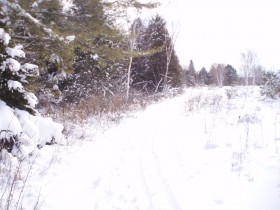 Darkness comes early at Crossroads at Big Creek, and so often we look out at our evergreen forests as the stars are starting to come out. On clear, dry evenings, it almost looks like the firs and spruce are covered with twinkle lights. For the next few weeks, our programs will focus on evergreens and stars.
Darkness comes early at Crossroads at Big Creek, and so often we look out at our evergreen forests as the stars are starting to come out. On clear, dry evenings, it almost looks like the firs and spruce are covered with twinkle lights. For the next few weeks, our programs will focus on evergreens and stars.
Evergreens and stars bring to mind the oft-told story about Martin Luther. According to legend, Luther was walking through a dark German forest when he became aware of starlight glistening through the branches of the evergreen trees. He was so taken with the beauty of this sight, he chopped down a fir tree, took it home to his family and covered it with lighted candles in the attempt to replicate the beauty he had experienced that evening in the outdoors.
Luther brought about the Protestant Reformation and wrote some great hymns, but did he invent Christmas tree? No. It’s a legend. A very lovely legend, but there is absolutely no evidence Luther was the first to decorate an evergreen to celebrate the season. None.
Actually, evergreens have been used in celebrations since the beginning of history. Egyptians, Persians, Greeks, and Romans all used evergreen wreaths and garlands. Evergreens smelled wonderful and they also were pretty.
In the northern parts of Europe, many primitive people worshiped trees. Evergreen trees seemed special because they stayed green all winter. Perhaps ancient people brought evergreen trees into their huts to remind themselves that spring would follow winter.
But scholars think evergreens became a part of the holiday season for several other reasons. In the Middle Ages, people used to put on plays at Christmastime. The most popular play was about Adam and Eve. A fir tree decorated with apples represented the Garden of Eden. Presumably, people thought the green trees decorated with apples were attractive, so they started putting trees up in their own homes.
Another popular custom of long ago was decorating a Christmas pyramid. People would put up a special stand for candles. As the name suggests, the pyramid would be wide at the bottom and come to a point at the top. On each level was a little shelf. Some scholars believe that people started using trees instead of candle stands. Because fir and spruce taper like pyramids, the families could light candles on each of the branches. Each whorl is just a bit shorter than the whorl below, so these sets of branches worked well as shelves for the candles.
Certainly, in nature, the pyramid shape helps evergreen trees survive. Evergreen needles are leaves, and they need sunlight. Because spruce, fir and pine are pyramid-shaped, the top branches do not shade the bottom branches. Each year, a new set of branches grows at the top of the tree and each of the lower branches grows approximately the same amount. That way each branch will be just a little longer than the branch above it. Every branch still will get sunlight, no matter how big the tree grows. And in the early evenings, every branch will get moon and starlight.
On Thursday, November 29, at 6:00 PM, Crossroads will offer a Night Hike to the Evergreen Forest. The hike will start and end at the the Crossroads Astronomy Campus and will visit several of the evergreen forests of the preserve. The hike will last about an hour .
Then, the Door Peninsula Astronomical Society will present the first of four free introduction to the night sky sessions. Designed to teach the basics, this “Intro to the Night Sky” begins at 7:00 at the Crossroads Astronomy Campus. This will be a clear skies event. To reach the Astronomy Campus, enter the Utah Street Entrance (at the Cove Road intersection)
On Saturday, December 1, at 2:00 the history lecture will be “The History of Christmas Trees.” This Power-Point Presentation will describe the evergreen tradition and then will explore the characteristics of native evergreen trees. The program is free and open to the public.

